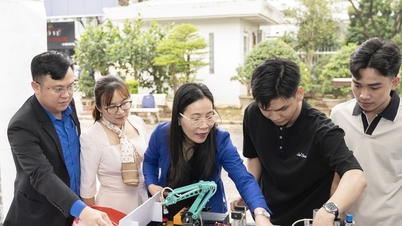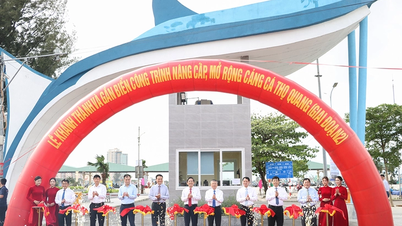

Faced with the difficulties and time-consuming nature of attendance tracking, monitoring, and classroom quality management in schools, a team of students from the Central Power College, including Bui Nhu Quynh, Nguyen Thanh Tuan, and Dang Huy Hung, with the support of their teacher Ho Van Vinh, successfully researched and applied a solution for attendance tracking, monitoring, and classroom quality assessment through facial recognition – CEPC AI. This solution is not only applicable in educational environments but also highly feasible for managing and evaluating the quality of personnel and employees in companies and corporations.

According to teacher Ho Van Vinh, lecturers have long needed tools to effectively manage class time. Manual attendance taking is time-consuming and lacks comprehensiveness, as it only tracks the number of students at a specific time. Furthermore, the quality of the class is also a concern for lecturers and educational administrators.

The challenge is how to recognize students' emotions, attitudes, and levels of concentration in order to guide the pace of the class and improve teaching effectiveness. These requirements render traditional attendance methods using cards, fingerprints, or facial recognition at the classroom door unsuitable.

According to Mr. Vinh, within a given space, strategically placed cameras can be used to record attendance, continuously update the number of students on the software, assess their concentration, work attitude, and learning style, and display reports to the manager.
Specifically, for members whose facial recognition is integrated into the software, the system will read the data, and if it detects a stranger, it will alert the manager. This application is likely suitable for both educational environments and the offices of small and medium-sized startups.
According to Mr. Le Van Huong , Secretary of the Youth Union of the Central Power College, the school has continuously encouraged and motivated students to develop their creativity to come up with novel startup ideas. For ideas with high feasibility, the school will assign lecturers and professional staff to provide timely support and guidance.

"Regarding the CEPC AI system solution for attendance tracking, monitoring, and managing classroom quality assessment through facial recognition, created by Mr. Vinh and his students, which won third prize in the 2024 Quang Nam Startup Talent Search competition, the school has provided many favorable conditions for the group to implement it."
"The school and a business are currently implementing it. Some features in the software need further upgrading and will be registered for intellectual property rights, packaged, and launched to the market in the near future," Mr. Huong said.

Leveraging their strong student body trained in construction, electrical, and plumbing-related fields, a group of students from Quang Nam College, including Nguyen Van Quoc and Nguyen Van Hung (Automotive - Mechanical - Construction Department) and their teacher Le Huu Hung (Deputy Director of the Southern Quang Nam Training Center), researched and developed a project providing multi-purpose services for handling civil and industrial construction problems. The project won third prize at the 2024 Quang Nam Startup Talent Search competition.

Teacher Le Huu Hung stated that the current market demand for services to address issues related to waterproofing, leaks, electrical short circuits, water leaks, etc., is very high. However, construction companies currently only accept multi-item contracts, or if they do, some electricians and plumbers handle the problems, but homeowners are not prioritized because they are also working on other projects.

Meanwhile, at Quang Nam College, many outstanding students in construction and electrical-plumbing fields could not find suitable part-time jobs to supplement their income. Recognizing this gap, Mr. Hung, along with two students, Quoc and Hung, came up with the idea of developing a project to provide these services, utilizing the college's excellent and highly skilled students to implement it.

The team led by Mr. Le Huu Hung uses social media tools like Facebook and Zalo OA to run advertisements and introduce services to customers. People habitually search the internet for services when they need assistance with an issue. The team's multi-purpose social media service page includes a hotline and mailbox where customers can leave information and images of the space or items needing assistance. The information portal staff will quickly receive the information and send a service quote. Once the customer agrees to the price, the service will send the personal information of several students specializing in the relevant field who are capable of handling the issue, allowing the customer to choose and know exactly who will come to their home for peace of mind.

According to teacher Le Huu Hung, due to limited funding, the project currently relies on social media channels, a hotline, and requires staff to operate the portal to communicate with customers and technicians. In the future, once investors are secured, the project will develop a mobile application that customers can use to perform all necessary actions, from selecting the problem they need to resolving, sending information and images, receiving quotes, and choosing a technician.
Through this application, students only need to leave their information and academic achievements in their major, and after a single skills test, they can become technicians for the project. When a client needs their services and selects a student, the application will send a notification to that student's phone, and they will participate in the work. Depending on the nature of the problem, the application will assign one or more technicians to handle it.
"Currently, there are many universities and colleges nationwide that offer training in construction, electrical and plumbing engineering, and the project can be widely implemented. Moreover, this will be a quality job channel for graduates. We hope to receive attention and investment to implement the application, providing useful solutions for the people and creating sustainable jobs for students," said Mr. Le Huu Hung.

Over the years, the issue of waste sorting at source has been actively promoted among the people by various levels of government, sectors, and organizations. However, these programs have not been very effective and remain at the level of mere campaigns. Mr. Le Van Minh (Giao Ai village, Dien Hong commune, Dien Ban town) shared that, through his survey, many people understand the positive impact of sorting waste at source, but due to a lack of tools and motivation, this issue has not received sufficient attention.

As someone working in the machinery manufacturing industry and concerned about environmental issues, Mr. Minh came up with the idea for a paid waste management and sorting device. Specifically, this device allows people to bring in waste, which will then be sorted into recyclable, organic, and hazardous waste categories. For recyclable waste, people will receive a corresponding amount of money, while for hazardous waste, they will have to pay for collection and processing by the relevant units.
"This waste ATM solves the problem of providing people with tools to sort their waste and, more importantly, creates motivation through the money received from recycling. As for hazardous waste, they have to pay a fee, at a reasonable rate; if they litter, they will be fined a much larger amount," Mr. Minh said.

To operate a paid waste sorting ATM, information technology is applied through an ERP model (an integrated technology model encompassing data collection, analysis, and sorting) and a smartphone application. Accordingly, people bring their waste to the ATM location, declare their identification code via QR code through the smartphone application, enter their information, and choose a payment method through their bank account or personal financial applications. The management agency assigns personnel and specialized vehicles to collect the waste at the ATM and then transport it to a processing or recycling plant. Because there is no sorting step, the processing and recycling process at the plant will be very efficient. The operation and management center for the waste ATMs will have access to all information through the ERP software and the smartphone application containing customer data.
Mr. Minh shared: "For the waste ATM project to be feasible, it requires the cooperation of the government in strictly enforcing environmental laws and regulations. In developed countries, simply littering will result in a fine notice being sent to the household. In Vietnam, although there are many regulations, they are only deterrent and warning in nature. Therefore, for the time being, this ATM will be suitable for school environments, apartment complexes, and businesses with a large workforce..."

According to Mr. Minh, the investment cost for each garbage ATM is approximately 3 billion VND, so his project is still just an idea and has been recognized by the Provincial People's Committee as an innovative startup idea for 2024. Recently, he was fortunate to connect with an investor in Ho Chi Minh City, who will soon invest in implementing these garbage ATMs on a pilot basis in several locations in major cities.

Source







![[Photo] Prime Minister Pham Minh Chinh attends the Conference on the Implementation of Tasks for 2026 of the Industry and Trade Sector](/_next/image?url=https%3A%2F%2Fvphoto.vietnam.vn%2Fthumb%2F1200x675%2Fvietnam%2Fresource%2FIMAGE%2F2025%2F12%2F19%2F1766159500458_ndo_br_shared31-jpg.webp&w=3840&q=75)







































































































Comment (0)